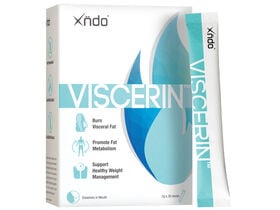Visceral Fat - The Invisible Killer

Visceral fat: why it's dangerous and how to lose it
The word "fat" has many meanings in today's world. If we're talking about our wallet, fat is a good thing. However, in our bodies, too much of the wrong kind of fat can shorten our lifespan. We usually only concern ourselves about fat in regard to our appearance, but what lies unseen beneath the surface could be slowly killing us. High levels of visceral fat, sometimes referred to as "belly fat" or "active fat" is a major cause of a wide range of severe, even life-threatening, health conditions. In the paragraphs below, we will discuss what visceral fat is, how a high level of visceral fat can adversely affect your health, how to identify the symptoms of high visceral fat, and what you can do to get rid of it.
What Is Visceral Fat?
The human body stores fat in different places. Visceral fat is body fat that is stored in the abdominal cavity, as opposed to subcutaneous fat, which is stored just below the skin. In most cases, subcutaneous fat makes up about 90% of a person's total body fat, with the remaining 10% made up of visceral fat.
Visceral fat is also known as active fat, due to the way it can actively raise the risk of a variety of severe health problems. Among its many adverse effects is potentially dangerous damage to normal hormone function. A body that stores higher amounts of visceral fat runs a higher risk of health problems like Type 2 diabetes, for example.
Just because a person has belly fat does not mean it is necessarily visceral fat. If the belly area feels soft when it is poked, that is subcutaneous fat. The visceral fat lies beneath the firm abdominal wall, out of reach, surrounding important internal organs, including the liver, pancreas, and intestines. Visceral fat is also stored in the omentum. The omentum is an apron-like flap of tissue located beneath the abdominal muscles and covering the intestines. As the omentum fills with fat, it gets harder and thicker, causing the belly to grow larger.
Visceral Fat Health Risks
While everyone has a certain amount of visceral fat, avoiding larger quantities is a crucial step in avoiding increased risks of the following health conditions:
- Type 2 diabetes: Having a high amount of visceral fat has a direct effect on insulin resistance, which can lead to glucose intolerance and Type 2 diabetes. Research has shown that this may be caused by a retinol-binding protein, which causes the increase in insulin resistance.
- Heart disease: Higher volumes of visceral fat more than doubles a woman's risk of developing heart disease. Even when the women in the study made changes, such as not smoking, the levels remained nearly the same.
- Asthma: In another study involving women, those with a waist circumference of more than 35 inches were more than a third more likely to develop asthma, even if their weight was normal.
- Breast cancer: Studies have shown that premenopausal women who have abdominal obesity are at a greater risk for breast cancer than those with little visceral fat in the stomach cavity. Larger belly sizes have also been linked to a higher breast cancer risk among postmenopausal women.
- Colorectal cancer: People who have the most visceral fat are at three times the risk for developing precancerous polyps than those with the lowest level of visceral fat. Studies have also shown that adenomatous colon polyps are associated with insulin resistance, which may prove to be a major factor in raising a person's risk of cancer.
- Alzheimer's disease: Researchers have found that people in their early 40s that have very high abdominal fat levels were almost three times more likely to develop dementia, including Alzheimer's disease by their 70s and 80s. This study tested waist size and thigh circumference and the size of the thighs were not related to dementia in any way.
What Causes Visceral Fat?
One of the biggest contributing factors to the amount of visceral fat in the body is lifestyle. It has been proven that a diet, high in lean protein and healthy fruits, vegetables, and whole grains can keep the amount of visceral fat at a good level. However, a diet high in carbohydrates, such as sugar and white breads, and fats, including deep-fried foods and butter, can cause the body to store damaging amounts of visceral fat. A sedentary lifestyle is also a major contributor to the increase in visceral fat.
Unfortunately, there's more to the story than making good choices. As we age, out bodies change and often get bigger. Women in midlife can see an expected increase in their body fat proportions, more so than men. Fat begins to favor storage in the upper body instead of the hips and thighs. Even when there is no actual weight gain, your waist can grow by inches. This is due to the visceral fat pushing out against the abdominal wall. The visceral fat begins to fill the spaces around the abdominal organs and in the omentum. While subcutaneous fat produces a high proportion of helpful molecules, visceral fat produces a high proportion of potentially dangerous health effects. Visceral fat produces more cytokines, which are proteins that can cause low-level inflammation. This is a huge risk factor for heart disease and also creates a precursor to angiotensin, which causes blood vessels to constrict, making your blood pressure rise.
How Visceral Fat Develops
One of the most dangerous things about visceral fat is that we can't see it. It hides within the stomach cavity and covers our internal organs, causing unseen damage. As the amount of visceral fat increases, it pushes against the firm abdominal wall, causing the waistline to expand. It is often able to grow to dangerous levels in the body simply because it is invisible to our eyes.
Many times, in today's world, getting heavier is accepted as part of getting older. While it is true that the human body, especially a woman's, does store more fat as the body ages. With a worldwide focus on avoiding "body-shaming", people are being told to accept a person's weight, no matter what it is. While it is important to feel good about the body you live in, it is also important to take the best care of it that you can.
Visceral Fat Measurement
The only definitive way to diagnose visceral fat is by CT or MRI scan. These are very expensive and time consuming, however. Medical professionals have developed some general guidelines as a way of evaluating your approximate visceral fat content and at what risks your body is to serious health risks. Harvard Health has stated that around 10 percent of all body fat is visceral fat. By taking your total body fat measurement and dividing by ten you can estimate what your visceral fat amount is.
One of the easiest ways to check to see if you are at risk is to take your waist measurement. For example, a woman whose waist measures 35 or more inches is carrying a higher amount of visceral fat and is, therefore, at a higher risk for health problems from it. For men, a 40-inch waist measurement or more puts them at higher risk.
Visceral Fat Rating and Healthy Range
If an MRI or body fat analyzer is used to measure the visceral fat present, the result will be within a scale of 1 to 59. The higher the visceral fat rating is, the higher the amount of visceral fat in the body. A good visceral fat rating is under 13. If a person scores higher than a 13, it indicates that he or she will have to start making changes to their diet and lifestyle immediately.
Visceral Fat Symptoms
The problem with visceral fat is that is hides behind the abdominal wall. We can't always see signs that our bodies are being damaged by visceral fat until severe health problems have already begun. Things like the raising of your blood pressure and blood glucose levels can creep up so slowly that your body becomes acclimated to these increased levels. The more time that passes, the more damage is being done.
One of the most noticeable ways to spot visceral fat is the size of your waist. If you are female, a waist size below 35 inches is what you want. For men, you want to see a waistline of less than 40, to ensure that your body is not storing a damaging amount of visceral fat.
How to Lose Visceral Fat
Exercise is a great way to lower your visceral fat level. Be sure to include both cardiovascular exercise and strength training into your regular routines. The cardio workout will raise your heart rate and the strength training will improve your muscle tone and size. Good examples of cardio exercise include running, swimming, cycling, and aerobics. Options for strength training include pushups, weights, and squats.
Lowering stress is also an effective weapon against visceral fat. When you are stressed, your body releases a hormone, cortisol, into the body. Cortisol increases the amount of visceral fat your body stores. Doctors have found that patients who reduce their high stress levels are better able to combat visceral fat. There are many methods of relaxation, including meditation and deep breathing exercises.
Visceral Fat Diet
Eating a healthy diet is crucial to taking off, and keeping off, the visceral fat. A healthy diet consists of lean proteins, fruits and vegetables, and complex carbohydrates, such as whole grains. It is also a diet low in foods containing high levels of sugar and fat. Generally, the fresher your menu, the healthier your diet. An easy way to visualize a healthy meal is to imagine how your dinner plate looks. When you look down at it, what do you see? A healthy dinner has vegetables covering half of the plate. The remaining half contains and equal amount of whole grains and lean protein. On the side, there should be a serving of dairy, such as milk or yogurt, and a serving of fruit. Avoid frying and opt for broiling, grilling, steaming, or boiling when cooking your food. Try to make protein choices like fish or chicken and limit the amount of red meat you eat each week.
Dietary changes don't have to be overwhelming. Start small, by cutting the amount of bread you eat or eliminating sugary drinks. Build your healthy eating plan one brick at a time and you will likely have more success than if you tried to change everything all at once. Remember, the important thing is not how quickly you can lose the visceral fat. The important focus should be on making sure you get rid of it once and for all.
Take Viscerin Visceral Fat Burner to get rid of visceral fat
Viscerin Visceral Fat Burner is suitable for individuals with high levels of visceral fat.
Best taken on an empty stomach before breakfast and bedtime, Viscerin Visceral Fat Burner is made with a high potency combination of ingredients that work synergistically to:
- Burn visceral fat to reduce visceral fat mass
- Reduce water retention to minimise excessive fluid build-up
- Boost metabolisum to promote fat-burning















